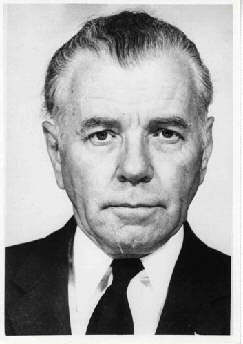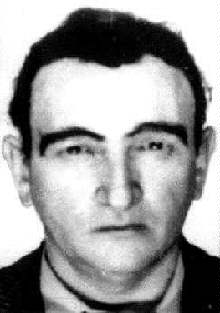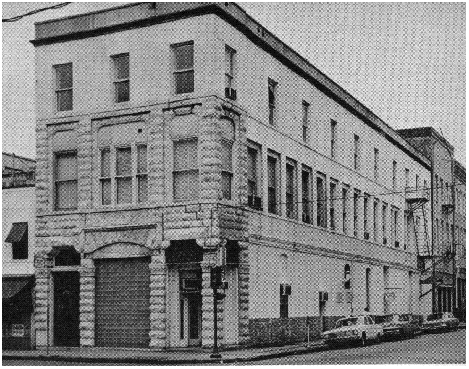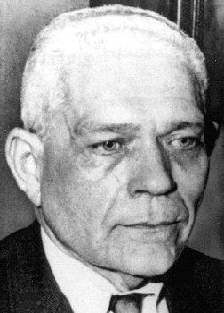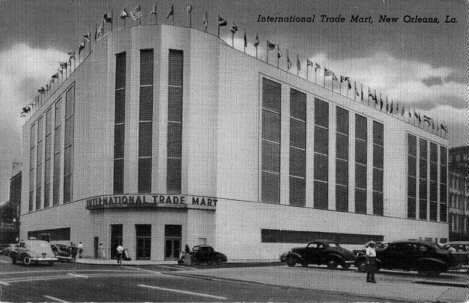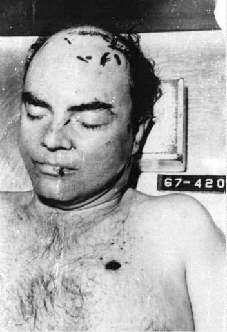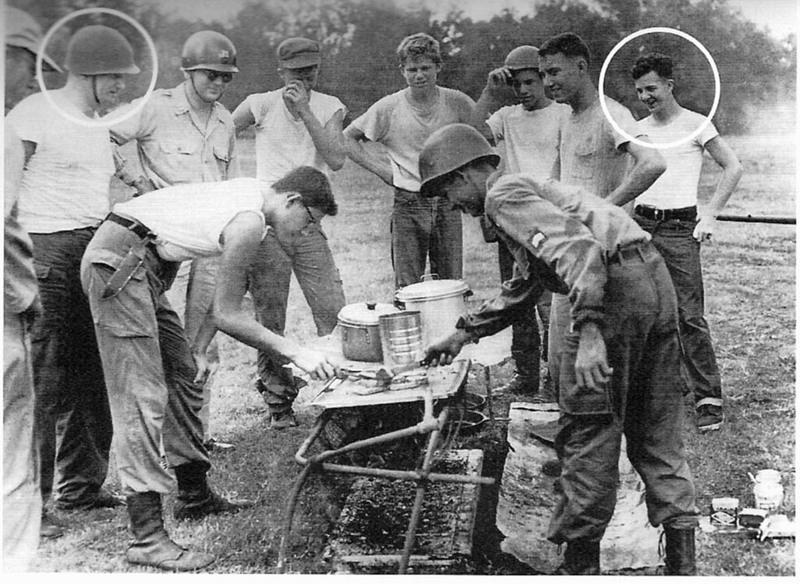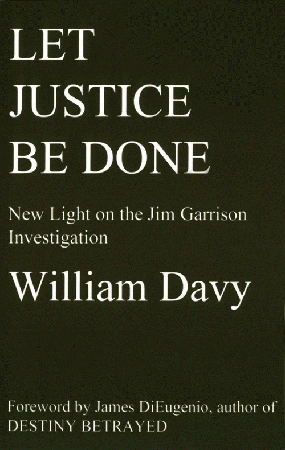|
The Jim Garrison Investigation "Garrison never denied that the Mafia was involved in the [JFK] assassination. The issue [for Garrison] was who planned the crime and whose idea was it and who was in control of it." --Joan Mellen, in a speech about her book, A Farwell to Justice, at the New York Society for Ethical Culture, 24 January 2006 "In 1975 a Senate committee headed by Frank Church found that the [Central Intelligence] Agency had planned a number of assassination operations, using everything from poison to machine guns and sometimes mob hit men" --Jim Garrison, District Attorney of New Orleans, On the Trail of the Assassins "We now know that the [Central Intelligence] Agency withheld from the Warren Commission the CIA-Mafia plots to kill Castro. Had the commission known of the plots, it would have followed a different path in its investigation.... Many have told me that the culture of the Agency is one of prevarication and dissimulation and that you cannot trust it or its people. Period. End of story. I am now in that camp." --Robert Blakey, staff director and chief counsel for the U.S. House Select Committee on Assassinations, statement from 2003 "The dalliance between American intelligence and the Mafia had begun in World War II, at a time when anything seemed justifiable if it helped the war effort. In the United States the Office of Naval Intelligence obtained the help of the Mafia's then 'don of dons,' Lucky Luciano, in preventing German sabotage in American dockyards. Through his close associate Meyer Lansky, Luciano mobilized his network of waterfront thugs accordingly and was rewarded by official leniency for his own past crimes." --Anthony Summers, Not in Your Lifetime "If possible, professional criminals will be hired to carry out specific selective 'jobs' [assassinations]." --Clandestine Operations Manual for Central America, a training manual written by the CIA "It's called in the intelligence lexicon, 'plausible deniability.' If they [CIA hired guns] perform actions that might embarrass the United States government, they can be denied [as being employed by the government]." --William Leary, Merton Coulter Professor of History and winner of the Central Intelligence Agency's Studies in Intelligence Award, interviewed in the documentary, Air America: The CIA's Secret Airline "Speaking of the CIA and FBI, Chief Justice Warren said, 'They and all other agencies do employ undercover men who are of terrible character.' Former CIA director Allen Dulles agreed, 'Terribly bad characters,' he said." --Anthony Summers, Not in Your Lifetime, citing Warren Commission Executive Session Transcripts, 27 January 1964, p. 163. "The agency 'deals with everything from bottom feeders around the world to their governments on a routine basis.'" --senior U.S. intelligence official, cited in Time magazine, 3 February 2003 "In late 1960, without the knowledge of President Dwight Eisenhower, the CIA had contacted underworld figures John Rosselli, Sam Giancana, and Santos Trafficante, offering them $150,000 for Castro's assassination. The gangsters were happy to be hired by the U.S. government to murder the man who had shut down their gambling casinos in Cuba. If they were successful, they hoped a U.S.-sponsored successor to Castro would allow them to reopen the casinos." --James Douglass, JFK and the Unspeakable: Why He Died and Why it Matters "Sometimes people sort of glaze over about the notion that the Mafia and U.S. intelligence and the anti-Castro activists were involved together in the assassination of President Kennedy. In fact, there's no contradiction there. Those three groups were all in bed together at the time and had been for several years in the fight to topple Fidel Castro." --Anthony Summers, journalist and assassination researcher, interviewed by Bill Curtis for the cable TV program, Investigative Reports, September 1991 "One of the Mob's big bases of operations was in Havana before the revolution, and Fidel [Castro] was cutting all that off ... severing the ties with the gambling casinos. The Mob worked shoulder to shoulder with the CIA's Mongoose people [against Castro], to the point that it became almost indistinguishable as to where the CIA activities stopped and Mob activities started." --John Stockwell, former CIA officer, interviewed by Frank Morrow for the TV program, Alternative Views, 1989 "The more we looked into it [the JFK assassination], the most productive area of investigation was clearly the CIA -- namely, those operatives who had worked with the anti-Castro Cubans." --Robert Tanenbaum, former Deputy Counsel for the U.S. House Select Committee on Assassinations, interviewed by David Talbot, Brothers: The Hidden History of the Kennedy Years "The accusations linger. In some minds the suspicions persist of a dark, unsolved conspiracy behind his [JFK's] murder. You can dismiss them, as many of us do, but knowing now what our secret government planned for Castro, the possibility remains: Once we decide that anything goes, anything can come home to haunt us." --Bill Moyers, for the 1987 documentary, The Secret Government: The Constitution in Crisis "...the real danger the CIA has always presented -- unbridled criminal stupidity, cloaked in a blanket of national security." --Gary Webb, Dark Alliance "After Castro overthrew Batista in January 1959, [Jack] Ruby began to provide weapons, now with CIA support, to anti-Castro Cubans. Ruby was working with another CIA-connected gunrunner, Thomas Eli Davis, III.... He told his first attorney, Tom Howard, that he 'had been involved with Davis, who was a gunrunner entangled in anti-Castro efforts.'" --James Douglass, JFK and the Unspeakable: Why He Died and Why it Matters "Now they're going to find out about Cuba, they're going to find out about the guns, find out about New Orleans, find out about everything." --Jack Ruby, Oswald's assassin, HSCA Report, vol. IX: V, p. 162. (Ruby made this comment to his former employee, Wally Weston who was visting him in jail.) The following text is excerpted from the book, Crossfire by Jim Marrs:
On the afternoon of November 22, 1963, two men sat drinking in the Katzenjammer Bar, located in New Orleans next door to 544 Camp Street, where a puzzling parade of anti-Castro Cubans and intelligence agents -- including Lee Harvey Oswald -- were seen the previous summer. (see The Patsy) One of the men was Guy Banister, the former FBI man who was running a private-investigation firm with intelligence connections out of an office at 544 Camp Street. The other man was one of his investigators, Jack Martin. According to a police report prepared that day, the two men returned to Banister's office where an argument erupted. Banister, his irritability inflamed by alcohol, accused Martin of stealing files whereupon Martin reminded Banister that he had not forgotten some of the people he had seen in Banister's office that summer. Banister then beat Martin over the head with a heavy .357 magnum pistol. In the heat of the moment, Martin screamed out: "What are you going to do -- kill me, like you all did Kennedy?" A police ambulance was called and carried the bloodied Martin to Charity Hospital.
An angered Martin soon whispered to friends that Banister had often been in the company of a man named David Ferrie, whom Martin claimed drove to Texas the day of Kennedy's assassination to serve as a getaway pilot for the assassins. He hinted at even darker associations. Martin's words soon reached the ears of New Orleans district attorney Jim Garrison, who quickly arrested Ferrie and began an investigation into the JFK assassination that eventually turned into a worldwide cause celebre. Because of the Garrison investigation much new assassination information became known and the assassination was addressed for the first time in a courtroom -- even though the defendant was finally acquitted. Garrison claimed that the entire weight of the federal government was moved to block and ridicule his investigation, and indeed there were many strange aspects to this entire episode, including an attack by some in the national media before Garrison even had a chance to present his case.... After hearing the remarks of Jack Martin, Garrison moved quickly enough. Over the assassination weekend, New Orleans lawmen vainly sought David Ferrie. On Monday, November 25, Ferrie turned himself in.
Garrison, who had met the bizarre Ferrie once before, could hardly forget the man. Ferrie suffered from alopecia, a rare disease that causes total baldness. He wrote:
Ill at ease, Ferrie admitted his Friday trip to Texas, claiming he wanted to go ice skating in Houston. However, he had no adequate answer for why he had chosen to drive through one of the worst thunderstorms in years and why, instead of skating, he had spent his time at the rink's pay phone. Ferrie also denied knowing Lee Harvey Oswald. Garrison was unsatisfied with Ferrie's story. He ordered him and two friends held in jail for questioning by the FBI. He later told interviewer Eric Norden:
[Note: In 1976, the National Archives reported that Ferrie's original statement was missing from its collection of assassination documents.] In On the Trail of the Assassins, Garrison wrote:
Over the next three years, Garrison's attention was centered on his job and family.... Garrison's view began to change after a chance meeting with the powerful senator from Louisiana, Russell Long. Garrison said Long told him: "Those fellows on the Warren Commission were dead wrong. There's no way in the world that one man could have shot up John Kennedy that way." It was a comment that was to put Garrison and his office back on the assassination investigation trail. First Garrison went back and studied the Warren Commission Report and volumes in detail. He was aghast:
Garrison, with his military background, was particularly shocked to read in the Commission volumes where a Lt. Col. Allison G. Folsom, Jr., reported on a grade made by Oswald in a Russian examination. Garrison knew that the mere fact that Oswald had been tested in Russian indicated intelligence training. Fired by growing suspicions, Garrison took another look at Oswald's activities while in New Orleans in the spring and summer of 1963. He began to discover the odd and mostly unexplained relationships between Oswald and the anti-Castro Cubans, Oswald and intelligence agents including the FBI, and Oswald and 544 Camp Street.
Quietly he began to assemble some of his most trusted assistants, whom he dubbed his "special team," and his investigation grew. Garrison reinterviewed Jack Martin and found that Oswald had been part of that strange entourage of agents in and out of Banister's Camp Street office. He found that Banister and his associates were involved in activities far afield from normal New Orleans activity -- honest or otherwise. There were tales of burglarized armories, missing weapons, raided ammunition caches and gun-running operations. Garrison wrote: "The Banister apparatus ... was part of a supply line that ran along the Dallas -- New Orleans -- Miami corridor. These supplies consisted of arms and explosives for use against Castro's Cuba." By 1966, Banister was dead -- he suffered a reported heart attack in June 1964 -- and Garrison was looking for a living person to prosecute in the conspiracy that he had begun to unravel. One starting point was New Orleans attorney Dean Andrews, who told the Warren Commission that he had received a call from a "Clay Bertrand" the day after the assassination asking him to fly to Dallas and legally represent Lee Harvey Oswald. Andrews reiterated this story to Garrison and claimed that while he had "Clay Bertrand" as a client, he had never actually met the man. As Garrison's investigators pried into the seamier areas of New Orleans nightlife, they began to piece together information from various sources that it was common knowledge in the homosexual underground that "Clay Bertrand" was the name used by none other than Clay Shaw, the respected director of the International Trade Mart in New Orleans.
Clay Shaw and Permindex
Claw Shaw, like Lee Harvey Oswald and Jack Ruby, was not simply a lone individual with no connections to persons and/or organizations that may have played a role in President Kennedy's death.... Shaw, a tall, distinguish man with silver hair and a polished manner, was born in Kentwood, Louisiana, on March 17, 1913. During the 1930s, Shaw was in New York City working as an executive for Western Union Telegraph Company and later as an advertising and public-relations consultant. By 1941, Shaw was with the U.S. Army and, while his official biography states simply that he was an aide-de-camp to Gen Charles O. Thrasher, Shaw later admitted he was working for the Office of Strategic Services (OSS) as a liaison officer to the headquarters of Winston Churchill. It was here that Shaw may have become entangled in the murky world of intelligence.... After the war, Shaw returned to New Orleans where he was known as a wealthy real-estate developer. He also became director of the International House -- World Trade Center, a "nonprofit association fostering the development of international trade, tourism and cultural exchange." Soon Shaw left this organization to found the International Trade Mart, which was quite profitable sponsoring permanent industrial expositions in the Caribbean.
According to several separate sources -- including Garrison's files and an investigation by the U.S. Labor Party -- Shaw's International Trade Mart was a subsidiary of a shadowy entity known as the Centro Mondiale Commerciale ("World Trade Center"), which was founded in Montreal, Canada, in the late 1950s, then moved to Rome in 1961. The Trade Mart was connected with Centro Mondiale Commerciale (CMC) through yet another shadowy firm named Permindex (PERManent INDustrial EXpositions), also in the business of international expositions. It is fascinating to note that in the 1962 edition of Who's Who in the South and Southwest, Shaw gave biographical information stating that he was on the board of directors of Permindex. However in the 1963-64 edition, the reference to Permindex was dropped. In the late 1960s, both Permindex and its parent company, Centro Mondiale Commerciale, came under intense scrutiny by the Italian news media. It was discovered that on the board of CMC was Prince Gutierrez di Spadaforo, a wealthy aristocrat who had been undersecretary of agriculture under the dictator Benito Mussolini and whose daughter-in-law was related to Nazi minister of finance Hjalmar Schacht; Carlo D'Amelio, an attorney for the former Italian royal family; and Ferenc Nagy, former premier of Hungary and a leading anticommunist.... Whatever the truth behind Centro Mondiale Commerciale and its companion company, Permindex, the Italian government saw fit to expel both in 1962 for subversive activities identical to those in the much-publicized Propaganda-2 Masonic Lodge scandal of more recent years. The news media in France, Italy, and Canada had a field day tying the two discredited firms to the CIA. And there is now evidence that Shaw indeed was CIA connected. Victor Marchetti, former executive assistant to the deputy director of the CIA and author of The CIA and the Cult of Intelligence, has revealed that in early 1969, he learned from CIA director Richard Helms that both Clay Shaw and David Ferrie had worked for the Agency. Marchetti said Helms repeatedly voiced concern over the prosecution of Shaw and even instructed top aides "to do all we can to help Shaw." Further, a CIA memo dated September 28, 1967, to the Justice Department -- finally made public in 1977 -- reveals that Shaw had provided the Agency with some thirty reports between the years 1949 and 1956. It may also be pertinent that in May 1961, just after the disastrous Bay of Pigs Invasion, Shaw introduced CIA deputy director Gen. Charles P. Cabell to the Foreign Policy Association of New Orleans. [Note: Gen. Charles Cabell was the brother of Dallas mayor Earle Cabell. Gen. Charles Cabell branded President Kennedy a "traitor" for refusing to use U.S. military power to salvage the Bay of Pigs Invasion.] Garrison wrote:
By late 1966, Garrison had two suspects in mind in the murder of President Kennedy -- the strange David Ferrie and the socially connected Clay Shaw.... [In 1961], Ferrie was introduced to a meeting of the New Orleans Civic Club as one of the pilots involved in the ill-fated Bay of Pigs Invasion. Ferrie made a bitterly anti-Kennedy talk. Ferrie also made an anti-Kennedy talk to the New Orleans Chapter of the Military Order of World Wars in which he said Kennedy "double-crossed" the invasion force by failing to authorize needed air support. Ferrie's speech was so vitriolic that several members of the audience walked out. As Garrison continued his investigations, he found abundant evidence that Ferrie -- who had been in contact with Oswald -- was connected to Clay Shaw. Raymond Broshears, a long-time friend of Ferrie's, had seen Ferrie and Shaw together on several occasions.... Jules Ricco Kimble, a member of the Ku Klux Klan, told Garrison of being introduced to Shaw by Ferrie, as did a Ferrie acquaintance named David Logan. Nicholas Tadin, the head of the New Orleans musicians' union, told Garrison that he and his wife had sought out Ferrie for flying lessons when they saw Ferrie and Shaw together at New Orleans Airport. As Garrison's investigation broadened -- including trips to Dallas, Houston, and Miami by members of his "team" -- the secrecy surrounding his probe began to crumble. On February 17, 1967, the dam broke when the New Orleans States-Item published a story on Garrison's activities with the headline: DA HERE LAUNCHES FULL JFK DEATH PLOT PROBE. The story noted that the district attorney's office had spent more than $8,000 in travel and "investigative expenses." Countering the charge that he was simply seeking publicity, Garrison later wrote:
The local news story brought a deluge of media attention from across the nation. Reporters began arriving in New Orleans. The next day, Garrison was forced to come out in the open, announcing: "We have been investigating the role of the City of New Orleans in the assassination of President Kennedy, and we have made some progress -- I think substantial progress -- ... what's more, there will be arrests...." On February 22, 1967, less than a week after the newspapers broke the story of Garrison's investigation, David Ferrie -- his chief suspect -- was found dead in his cluttered apartment. His death was not entirely unexpected by Garrison. The day the newspaper story first ran, Ferrie had telephoned Garrison aide Lou Ivon to say: "You know what this news story does to me, don't you. I'm a dead man. From here on, believe me, I'm a dead man...." Garrison also was left without the man he later described as "one of history's most important individuals." And Ferrie was not the only person connected to the case to die. Banister reportedly died of a heart attack in June 1964, less than a month after his business partner, Hugh Ward -- an investigator who had worked closely with Ferrie -- died in a Mexico plane crash that also took the life of New Orleans mayor DeLesseps Morrison. Yet another man closely connected to Ferrie was Eladio del Valle, a wealthy former Cuban congressman under Batista who had fled Cuba to become a well-known organizer of anti-Castro Cubans in Miami. Del Valle reportedly had paid Ferrie $1,500 a mission to make air raids against Cuba. Three days before Ferrie's death, Garrison's investigators began trying to locate del Valle. Just twelve hours after Ferrie's death, del Valle's mutilated body was discovered in a Miami parking lot. Police reported that del Valle had been tortured, shot in the heart at point-blank range, and his skull split open with an ax. His murder has never been solved.
With Ferrie and del Valle dead, Garrison began to focus his attention on Clay Shaw. Fearing that Shaw might meet the same fate as Ferrie, Garrison moved rapidly. He and his "special team" had Shaw arrested on March 1, 1967. Loud and long, Shaw protested his innocence, stating flatly: "I never heard of any plot and I never used any alias in my life." The question of an alias came up as Shaw was being booked into jail. A police officer filling out forms asked Shaw if he had any aliases. Shaw replied, "Clay Bertrand," thus confirming the information that Garrison had been receiving from various sources around New Orleans. The officer duly noted this alias on his form. Between the time of his arrest and his trial, Shaw was allowed to go free after posting a $10,000 bail bond. As Garrison's men searched Shaw's house they found several interesting things such as two large hooks screwed into the ceiling of Shaw's bedroom along with five whips, several lengths of chain, and a black hood and cape. Shaw tried to shrug off this kinky collection as simply part of a Mardi Gras costume. Harder to shrug off was Shaw's personal address book, which contained the names of important persons in Italy, Paris, and London. But most intriguing was a listing for "Lee Odum, P.O. Box 19106, Dallas, Texas." What made this so in intriguing was that the address "P.O. 19106" also appears in the address book of Lee Harvey Oswald. Garrison announced that "P.O. 19106" actually was a code for Jack Ruby's unlisted Dallas telephone number and noted that the number was in the address books of both Shaw and Oswald. Interest in this issue dissipated rapidly following a May 17, 1967, story in the Dallas Times Herald revealing that Lee Odum was a real person living in Dallas.... This seemed to clear up the issue, except that the Times Herald noted that P.O. Box 19106 did not come into existence until 1965, when the post office substation involved was remodeled. Therefore, it remains to be explained why that particular box number appeared in Oswald's address book in 1963. To further titillate Garrison's interest, he found on an unused page of Shaw's address book the words "Oct" and "Nov" and, following an indecipherable scribble, the name "Dallas." After the arrest of Shaw, the U.S. government "awakened like an angry lion," according to Garrison.... Despite the federal government's protest that Garrison was on a "witch hunt," when his evidence was presented to a New Orleans grand jury, a true bill was returned. Clay Shaw was indicted on a charge that he "...did willfully and unlawfully conspire with David W. Ferrie, herein named but not charged, and Lee Harvey Oswald, herein named but not charged, and others, not herein named, to murder John F. Kennedy." To assure the public that he was doing only his sworn duty, Garrison even took the unprecedented step of having himself -- the prosecutor -- file for a preliminary hearing for Shaw. This hearing took place on March 14, 1967, before three judges, who reviewed Garrison's evidence. After studying Garrison's case for three days, the three-judge panel upheld the indictment and ordered Shaw to a jury trial. For the next year and a half, as the world waited for Garrison's case to be presented at Shaw's trial, the major news media of the United States lambasted the events in New Orleans. Garrison later wrote: "Some long-cherished illusions of mine about the great free press in our country underwent a painful reappraisal during this period...." An NBC program stated that one of Garrison's witnesses had lied under oath, but when requested to present their evidence to a New Orleans grand jury, news executives declined. In that same NBC program, Frank McGee claimed two of Garrison's star witnesses had failed their polygraph tests. Garrison publicly offered to resign if the network could substantiate this charge. Again, no proof was forthcoming.... [Note: NBC's program was so one-sided that Garrison was able, under the then-existing Fairness Doctrine, to press for "equal time" to respond to his critics. He was granted a half-hour which he spent discussing what he could of his case.] Shortly before the trial of Clay Shaw, Garrison believed he may have been the object of a setup to implicate him with a known homosexual and a former client. He escaped arrest and was shocked to learn that one of his "special team" members -- a former FBI man -- may have been responsible for the bizarre episode. However, before Garrison could question the man, he had hurriedly left New Orleans, taking many of the district attorney's files with him. Garrison also claimed that someone had "bugged" the telephones of his office, his home, and even his staff. The anti-Garrison media blitz coupled with the strange incidents surrounding his investigation prompted Garrison to claim that "a tremendous amount of federal power" had been arrayed against him in an effort to block his investigation of Kennedy's death. He voiced his concern over a fair trial when he told interviewer Eric Norden:
Garrison claimed this effort to stop him proved two things:
[Note: In the late 1970s, the U.S. House Select Committee on Assassinations uncovered evidence that the CIA planted nine agents inside the Garrison investigation to feed him false information and to report back to Langley on what Garrison was finding out.] But Garrison was not without supporters. A group of New Orleans businessmen, going under the name "Truth or Consequences," gave Garrison both moral and financial backing. Surprising solidarity came from Boston's Cardinal Richard Cushing, father confessor to the Kennedy family, who commented: "I think they [the investigation in New Orleans] should follow it through.... I never believed the assassination was the work of one man." Another odd show of support for Garrison came years later from a most unlikely source. Shortly before his disappearance, Teamster boss Jimmy Hoffa stated: "Jim Garrison's a smart man ... goddamned smart attorney.... Anybody thinks he's a kook is a kook themselves." There is some evidence that Robert Kennedy also took Garrison's probe seriously. He indicated to his friend Arthur M. Schlesinger, Jr., that he believed Garrison might be onto something. But when his staff once began to tell him about Garrison's findings, he turned away, saying: "Well, I don't think I want to know." By January 29, 1969, the day the Clay Shaw trial finally got under way, Garrison's case was already foundering. His chief suspect, Ferrie, was dead and others had fled New Orleans and were safe in other states that refused to honor Garrison's extradition requests. Governor John Connally, himself a victim in Dallas, refused to extradite Cuban leader Sergio Archaca-Smith, while California governor Ronald Reagan declined to allow extradition for one Edgar Eugene Bradley. Garrison, in a mistake that was to cost him further credibility, apparently had mistaken Bradley for Mafia man Eugene Hale Brading who was arrested in Dealey Plaza shortly after the assassination. But Garrison's major "missing witness" was Gordon Novel, a young electronics expert who eventually became embroiled in some of this nation's most controversial cases. Novel first approached Garrison in early 1967 with information about David Ferrie and Cuban exile activities, but soon Garrison came to believe that Novel was a CIA "plant." After Garrison subpoenaed Novel, he fled to Ohio where Governor James Rhodes -- despite a personal call from Governor John McKeithen of Louisiana -- refused to allow extradition.... A note left behind in his New Orleans apartment, which was later authenticated as being written by Novel, mentioned his work for Double Check Corporation, a CIA "front" located in Miami. The letter stated: "Our connection and activity of the period [with Double Check] involves individuals presently ... about to be indicted as conspirators in Mr. Garrison's investigation." In 1974, Novel, who claimed to have worked for the CIA, met with President Nixon's special counsel Charles Colson and discussed developing a special "de-gaussing" machine that would erase Nixon's incriminating White House tapes from afar. Novel also cropped up as an electronics expert in the case of automobile magnate John DeLorean. Despite the media attacks and missing witnesses, Garrison gamely moved ahead with his prosecution of Clay Shaw. His goals were twofold: 1) convince the jury that a conspiracy was behind President Kennedy's death and 2) prove that Clay Shaw was part of that conspiracy. Garrison achieved the first goal but failed on the second. After a string of witnesses from Dallas -- including the Bill Newmans and railroadman James L. Simmons and others not called before the Warren Commission -- told of shots to Kennedy's front and medical testimony pointed out the shortcomings of the President's autopsy, the jury became convinced of Garrison's charge that a conspiracy had existed. This conviction solidified when the jury viewed the Zapruder film of the assassination -- made available for the first time due to Garrison's subpoena power. After the trial, every juror agreed that Garrison had convinced them that Kennedy had died as the result of a conspiracy. However, the evidence of Shaw's involvement proved not as convincing. Despite several credible people who testified they had seen David Ferrie and Lee Oswald with a man matching Clay Shaw's description -- including several prominent residents of Clinton, Louisiana -- many jurors remained skeptical.... Garrison's strongest piece of evidence was Shaw's jail card, which showed he used the alias Clay Bertrand. Yet Criminal District Court judge Edward Aloysius Haggerty refused to allow the jail card to be introduced as evidence, saying Shaw had not been allowed to have a lawyer with him during the booking procedure.... With the judge's [decision], Garrison's case -- already severely weakened by dead, incredible, and unobtainable witnesses -- collapsed.
Links: "The reporter's mind recoils at the notion that any intelligence service would be misguided enough to hire a David Ferrie, but one qualified source has claimed there was a CIA connection. Victor Marchetti [former special assistant to CIA Director Richard Helms] told me that he observed consternation on the part of then CIA Director Richard Helms and other senior officials when Ferrie's name was first publicly linked with the assassination in
1967. Marchetti claimed he asked a colleague about this and was told that 'Ferrie had been a contract agent to the Agency in the early sixties and had been involved in some of the Cuban activities.'" --Anthony Summers, Not in Your Lifetime "By the 1950s, 75% of US imports from Latin America came through the port of New Orleans. Civic and business leaders of the Crescent City throughout the decades forged closer business, political and social ties with their Latin American counterparts. Fidel Castro's rise to power sent shock waves through New Orleans and threatened a lucrative mutual relationship." --Frank DeBenedictis, A Short History of INCA "There's a number of things that I believe that [Clay] Shaw testified to that I did not believe. I believe he was lying to the jury. Of course, the jury probably believed him. But I think Shaw put a good con job on the jury." "This story isn't going to die as long as there's a real reporter alive -- and there are a lot of them." "I remember discounting everything Garrison had said. I had a negative point of view about Garrison based upon all the reportage that had gone on. And then I read all this material that had come out of [CIA Director Richard] Helm's office, that in fact what Garrison had said was true. They [CIA agents] were harrassing his witnesses, they were intimidating his witnesses." "Give Garrison nothing!" "Goddamn the Kennedys. First there was Jack, now there's Bobby, and then Teddy. We'll have them on our necks until the year 2000." "The thing I am concerned about, and so is [Deputy Attorney General Nicholas] Katzenbach, is having something issued so we can convince the public that Oswald is the real assassin." "I've done a study of Garrison. I came out of it thinking that he's one of the really first rate, class act heroes of this whole ugly story, which suffers so badly for heroes." "To show you how cosmically irrelevant the Warren Report is for the most part ... one of the exhibits is classified in the front as, 'A Study of the Teeth of Jack Ruby's Mother.' Even if Jack Ruby had intended to bite Oswald to death, that still would not have been relevant." "As Allen Dulles said -- one of the top people running the [Warren] investigation -- 'The American people don't read.' But, as it turns out, some of us do." "One of the stated objectives [of the Warren Commission] was to calm the fears of the people about a conspiracy. But in our country, the government has no right to calm our fears, any more than it has, for example, the right to exite our fears about Red China, or about fluoridation, or about birth control, or about anything. There's no room in America for thought control of any kind, no matter how benevolent the objective. Personally, I don't want to be calm about the assassination of John F. Kennedy. I don't want to be calm about a president of my country being shot down in the streets." "In retrospect, the reason for the assassination is hardly a mystery. It is now abundantly clear ... why the C.I.A.'s covert operations element wanted John Kennedy out of the Oval Office and Lyndon Johnson in it. The new President elevated by rifle fire to control of our foreign policy had been one of the most enthusiastic American cold warriors.... Johnson had originally risen to power on the crest of the fulminating anti-communist crusade which marked American politics after World War II. Shortly after the end of that war, he declaimed that atomic power had become 'ours to use, either to Christianize the world or pulverize it' -- a Christian benediction if ever there was one. Johnson's demonstrated enthusiasm for American military intervention abroad ... earned him the sobriquet 'the senator from the Pentagon....'" "[Richard] Schweiker told me in his opinion the CIA was responsible for the assassination. That's a heck of a statement to come from a United States Senator and one who had even been Ronald Reagan's running mate in 1976." "When I mentioned about Adlai Stevenson, if he was vice-president there would never have been an assassination of our beloved President Kennedy." --Jack Ruby's comment to reporters while being transferred to his prison cell. When asked to explain what he meant, Ruby (Oswald's killer and a probable conspirator in the JFK assassination) replied, "Well the answer is the man in office now [Lyndon Johnson]." Note: Adlai Stevenson advocated a conciliatory approach to international affairs in stark contrast to Democratic Party hawks like Lyndon Johnson. Johnson assumed the presidency following JFK's murder and escalated the Vietnam War exponentially. With his comment, it seems that Ruby was dropping a hint about the assassination -- that the JFK conspirators could not have achieved their goal of putting a hawk in the White House had Stevenson been Kennedy's vice-president instead of Johnson. "There are a great many things that I don't know about the assassination. I have never tried to pretend to know more than I do, although I have read magazine articles which have me saying things I haven't said, and indicating that I tend to know more.... But I can tell you generally what happened. Generally, what happened was this...." Jim Garrison - In His Own Words - 1967 Lecture (Audio) "Garrison's Case Finally Coming Together" by Martin Shackelford 9/11 - Anatomy of a Great Deception "Real patriots ask questions." --Carl Sagan |
